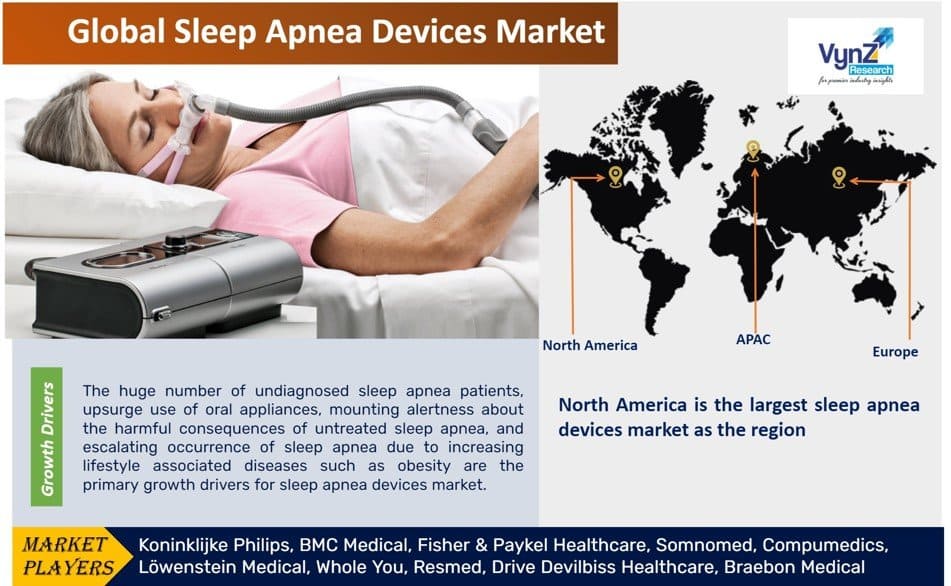| Status : Upcoming | Report Code : VRHC1015 | Industry : Healthcare | Available Format :

|

Global Sleep Apnea Devices Market – Analysis and Forecast (2025-2030)
Industry Insights by Type (Therapeutic Devices (Positive Airway Pressure Devices, Facial Interfaces, Oral Appliances, Accessories, Adaptive Servo-Ventilators and Others) Diagnostic Devices (Polysomnography Devices, Oximeters, Home Sleep Testing Devices, Actigraphy Systems and Sleep Screening Devices), by End-User (Sleep Laboratories & Hospitals and Homecare) and by Geography (North America, Europe, Asia-Pacific, Middle East, South America and Rest of the World)
Industry Overview
Sleep apnea is chronic and progressive health problem. There are numerous types of sleep apnea, although the most frequent type is obstructive sleep apnea. The global sleep apnea devices market is growing at significant rate due to escalating occurrence of sleep apnea and increasing lifestyle associated diseases. Different types of products contributed to the sleep apnea devices market size. The market has witnessed high demand for diagnostic devices over the last few years, due to mounting alertness about the harmful consequences of sleep disorder and mounting government and private organizations schemes regarding sleep disorder.

Market Segmentation
Insight by Type
There are two types of devices, diagnostic devices and therapeutic devices. Of both therapeutic device account for major share in the sleep apnea devices market, due to increasing diagnosis and mounting alertness about the harmful consequences of sleep apnea. Moreover, the therapeutic device market is also expected to grow at the fastest rate during the projected period. The therapeutic device market is further segmented into positive airway pressure devices, facial interfaces, oral appliances, accessories, adaptive servo-ventilators and others.
The positive airway pressure device (PAP) segment account for the major share in the sleep apnea therapeutic device market. The oral appliance segment is expected to grow at fastest rate due to advantage of oral appliances over other devices and increasing issues associated with PAP compliance.
The diagnostic device market is further subdivided into polysomnography devices, actigraphy systems, home sleep testing devices, sleep screening devices and oximeters. The polysomnography hold the largest share in the sleep apnea diagnostic device market. Moreover, the actigraphy system segment is expected to grow at the fastest rate due to its high sensitivity during the sleep study process.
Insight by End-User
The global sleep apnea devices market has also been segmented by end-user into hospitals & sleep laboratories, and homecare. The homecare category is expected to exhibit the faster growth in demand for sleep apnea devices in the market due to increasing number of patients undergoing sleep testing in at hospitals and sleep laboratories.
Global Sleep Apnea Devices Market Report Coverage
|
Report Metric |
Details |
|
Historical Period |
2018 - 2023 |
|
Base Year Considered |
2024 |
|
Forecast Period |
2025 - 2030 |
|
Market Size in 2023 |
U.S.D. xx.x Billion |
|
Revenue Forecast in 2030 |
U.S.D. xx.x Billion |
|
Growth Rate |
x.x% |
|
Segments Covered in the Report |
By Type and By End-User |
|
Report Scope |
Market Trends, Drivers, and Restraints; Revenue Estimation and Forecast; Segmentation Analysis; Impact of COVID-19; Companies’ Strategic Developments; Market Share Analysis of Key Players; Company Profiling |
|
Regions Covered in the Report |
North America, Europe, Asia-Pacific, Middle East, South America and Rest of the World |
Industry Dynamics
Growth Drivers
The huge number of undiagnosed sleep apnea patients, upsurge use of oral appliances, mounting alertness about the harmful consequences of untreated sleep apnea, and escalating occurrence of sleep apnea due to increasing lifestyle associated diseases such as obesity are the primary growth drivers for sleep apnea devices market. For instance, according to World Health Organization (WHO) in 2016, more than 1.9 million adults aged 18 years and older were overweight and 650 million were obese. In addition, approximately 2.8 million people are dying each year due to obesity and overweight.
Growing initiative of market players, unhealthy sleep patterns and postures and increasing government schemes to increase alertness regarding sleep apnea are also fueling the growth of the market. Development of technologically advanced products, increasing healthcare expenditure, high stress levels and increasing focus on home healthcare are also some of the drivers for the sleep apnea devices industry growth. The various technological advancements are brought by sleep apnea device players to make the products comfortable for patients.
Challenges
The lack of patient compliance, long waiting period, penetrating cost related with products and complex referral pathways are the major challenges for the growth of sleep apnea devices market.
Industry Ecosystem
The diagnostic device manufacturers are expected to have enormous opportunities, as the governments in various countries are introducing initiatives associated with healthcare expenditure for sleep apnea. The survival of new entrants and small players is a challenge in the sleep apnea devices market due to high capital investment and stringent regulatory requirements for the approval process.
Geographic Overview
Geographically, North America is the largest sleep apnea devices market as the region has high growth of home sleep testing devices, technologically advanced devices, and release of grants and finances by private and government institutions to encourage alertness of sleep apnea. In addition, increasing healthcare expenditure, and increasing prevalence of lifestyle associated disease such as obesity which further escalating occurrence of sleep apnea are also fueling the growth of the North American market. For instance, according to Centers for Disease Control and Prevention (CDC) in 2011-2014 more than 36.5% adults in the U.S. were obese.
Asia-Pacific is observed to witness fastest growth in the market as the region comprise of largest population. In addition, escalating occurrence of sleep apnea and initiatives by government and private organizations to establish alertness regarding sleep disorder is also creating a positive impact on the sleep apnea devices industry growth in the region.
Competitive Insight
Key players in the sleep apnea devices market are investing in the development of innovative and advance products, which is strengthening their position in the market. In March 2018, Philips announced the opening of Southeast Asia’s first Sleep and Respiratory Education Center in Singapore, to provide free sleep and respiratory care training. Koninklijke Philips, BMC Medical, Fisher & Paykel Healthcare, Somnomed, Compumedics, Löwenstein Medical, Whole You, Resmed, Drive Devilbiss Healthcare, Braebon Medical are the key players offering sleep apnea devices products.
The Sleep Apnea Devices Market report offers a comprehensive market segmentation analysis along with an estimation for the forecast period 2025–2030.
Segments Covered in the Report
- By Type
- Diagnostic Devices
- Therapeutic devices
- By End-User
- Hospitals & sleep laboratories
- Homecare
Geographical Segmentation
- North America
- U.S.
- Canada
- Mexico
- Europe
- Germany
- U.K.
- France
- Italy
- Spain
- Russia
- Rest of Europe
- Asia-Pacific (APAC)
- China
- Japan
- India
- South Korea
- Rest of Asia-Pacific
- Rest of the World (RoW)
- Brazil
- Saudi Arabia
- South Africa
- U.A.E.
- Other Countries
.png)
Source: VynZ Research
.png)
Source: VynZ Research
Frequently Asked Questions
Purchase Options
Latest Report
Research Methodology
- Desk Research / Pilot Interviews
- Build Market Size Model
- Research and Analysis
- Final Deliverabvle
Connect With Our Sales Team
- Toll-Free: 1 888 253 3960
- Phone: +91 9960 288 381
- Email: enquiry@vynzresearch.com
Sleep Apnea Devices Market
